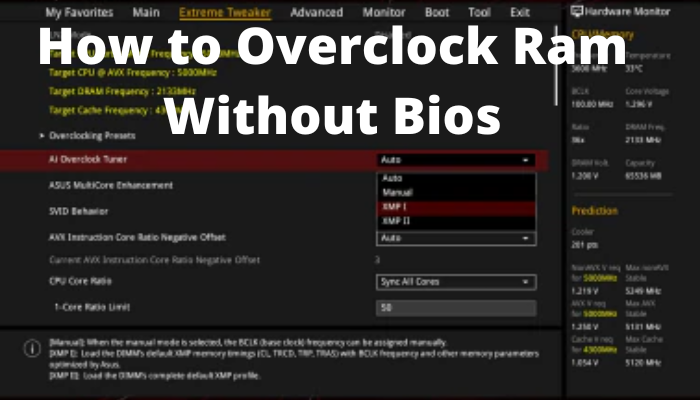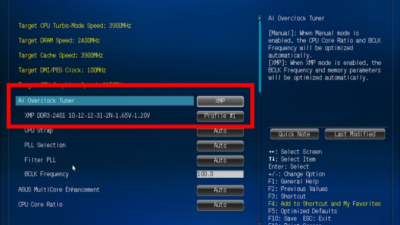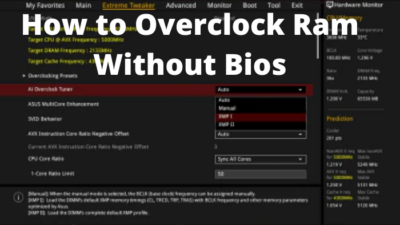There are many reasons why you might want to overclock your RAM. Maybe you’re trying to get a little more performance out of an aging system, or maybe you just want to see how far you can push your hardware. Whatever the reason, overclocking RAM without BIOS is possible, and in this article we’ll show you how. Keep in mind that overclocking can void your warranty, so proceed at your own risk. With that said, let’s get started!
What Is Overclocking and Why Would You Want To Do It
Overclocking is the process of forcing a computer component to run at a higher speed than its stock settings. It’s usually done with the CPU or GPU, but it can also be applied to RAM. Overclocking can give your system a performance boost, but it also comes with risks. The extra heat generated by overclocked components can shorten their lifespan, and pushing things too far can result in permanent damage. That’s why it’s important to know what you’re doing before you start overclocking. Although BIOS-based overclocking is the safest and most reliable method, it’s not the only way to overclock. In this guide, we’ll show you how to overclock without BIOS. First, identify the limitations of your system. Make sure you have adequate cooling and a stable power supply. Then, find out what parts of your system can be safely overclocked. Once you’ve done that, you can start pushing your components to their limits. With a little trial and error, you’ll be able to find the perfect balance of speed and stability for your system. Just remember to take things slowly and always keep an eye on temperatures. With a bit of care, you can enjoy the benefits of overclocking without any of the risks.
The Basics of Overclocking Your Ram Without a Bios
Overclocking your ram without a bios is not as difficult as it may seem. There are a few things that you need to keep in mind, but with a little patience, you can easily overclock your ram without a bios. The first thing that you need to do is to find the right setting in your motherboard’s control panel. Once you have found the right setting, you need to adjust the frequency of your ram. If you are not sure about the frequency, you can always consult the manual that came with your motherboard. After you have adjusted the frequency, you need to save the changes and restart your computer. Once your computer has restarted, you need to check if the new frequency is stable. If it is not stable, you need to adjust the voltage of your ram. Once you have found the right voltage, you should be able to overclock your ram without a bios.
How To Test for Stability and Performance Gains
Overclocking your RAM is a great way to get the most out of your system, but it’s important to do it right. The last thing you want is to damage your hardware or void your warranty. In this guide, we’ll show you how to overclock your RAM without BIOS. We’ll also go over some basic stability and performance testing so you can be sure that your new settings are working properly. First, you’ll need to increase the voltage to your RAM. This can be done by either increasing the VDIMM or by increasing the memory voltage in your BIOS. Next, you’ll need to increase the frequency of your RAM. This is usually done by multiplying the base clock by a certain factor (for example, if your base clock is 100MHz, you would multiply it by 1.1 to get 110MHz). Once you’ve increased the voltage and frequency of your RAM, it’s time to test for stability. The best way to do this is with a tool like memtest86. This will stress-test your RAM and help you identify any potential problems. If memtest86 doesn’t find any errors, then Congrats! Your overclocked RAM is stable and ready for use. Finally, it’s always a good idea to run some benchmarks before and after you overclock your RAM. This will help you see any potential gains in performance. Some good benchmarks to run are 3DMark, Cinebench, and PCMark10. With these tools, you can easily test for stability and performance gains when overclocking your RAM without BIOS.
Tips and Tricks for Getting the Most Out of Your Overclocked Ram
One way to increase the performance of your computer is to overclock the RAM. This process involves changing the settings in the BIOS to make the RAM run faster than its standard speed. However, overclocking can be a risky proposition, and it is important to know what you are doing before you attempt it. Here are a few tips and tricks for getting the most out of your overclocked RAM:
- Test the RAM at its default speed before you attempt to overclock it. This will help you determine how far you can push the RAM without causing stability issues.
- Start with a small overclock and gradually increase it until you reach the desired speed. Again, stability is important, so take your time and don’t be afraid to back off if you start to experience problems.
- Pay attention to the temperature of your CPU and RAM. Overclocking can generate a lot of heat, so make sure that your cooling system is up to the task. Otherwise, you risk damaging your hardware.
By following these tips, you can safely overclock your RAM and enjoy improved performance without putting your system at risk.

















Comments